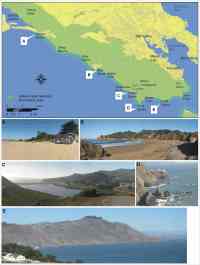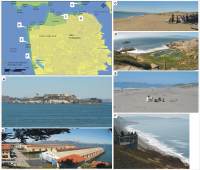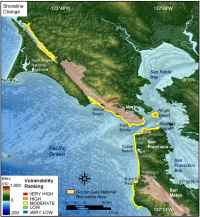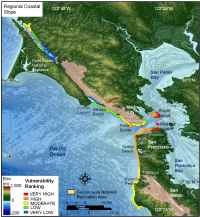Geologic Variables
 |
| Figure 3. Geomorphologic features within the northern section of GGNRA. Click on figure for larger image. |
The geomorphology variable expresses the relative erodibility of different landform types (Table 1). These data were derived from oblique aerial photography of the California coast (http://www.californiacoastline.org/). In addition, field visits were made within accessible locations of the park to ground-truth the geomorphologic classification (Figure 3 and Figure 4). GGNRA contained several geomorphology types, including low to very
 |
| Figure 4. Geomorphologic features within the southern section of GGNRA. Click on figure for larger image. |
low vulnerability rock cliffs, moderate vulnerability alluvium and unconsolidated cliffs with beaches, high vulnerability engineered and gravel beaches, and very high vulnerability sand beaches (Figures 3, 4, and 5). For locations with multiple geomorphologic types within a 1-minute section of coastline, the dominant morphology type was chosen to represent that section of coast.
Shoreline erosion and accretion rates for GGNRA were
calculated from data provided by the USGS National Assessment of Coastal Change Hazards project (Table 2) (Hapke and others, unpub. data). Shoreline rates of change (m/yr) were calculated at 50 m intervals (transects) along the coast using Digital Shoreline Analysis System (DSAS) software (http://woodshole.er.usgs.gov/project-pages/dsas/) to derive the rate of shoreline change for historic shorelines from 1880 -1998.
 |
| Figure 6. Shoreline change rates for GGNRA. Click on figure for larger image. |
The change rates for each transect within a 1-minute grid cell were averaged
to determine the shoreline change value used here, with positive numbers indicating accretion and negative numbers indicating erosion. Shoreline change rates within GGNRA mostly fell within +1 - -1 m/yr (moderate vulnerability) with a few small areas of high vulnerability (-1- -2 m/yr) (Figure 6). Historic shorelines were not available for  |
| Figure 7. Regional coastal slope for GGNRA. Click on figure for larger image. |
Alcatraz Island, Angel Island, and Tomales Bay, therefore, the moderate vulnerability category was assigned to these areas because 1) the majority of shoreline change rates for GGNRA fell within the moderate vulnerability category (+1 - -1 m/yr), and 2) much of the geomorphology of the shoreline in these areas is consolidated and is not likely to experience significant change within 1 year.
The determination of regional coastal slope is an indication of the relative vulnerability to inundation and the potential rapidity of shoreline retreat because low-sloping coastal regions should retreat faster than steeper regions (Pilkey and Davis, 1987). The regional slope of the coastal zone was calculated from a grid of topographic and bathymetric elevations extending 5 km landward and seaward of the shoreline. Elevation data were obtained from the National Geophysical Data Center (NGDC) as gridded topographic and bathymetric elevations at 0.1-meter vertical resolution for 1-minute grid cells. Regional coastal slopes for GGNRA fall within the very low to very high vulnerability category (< 4.55% - > 14.7%) (Figure 7).
Back to Top




